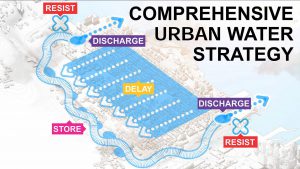A Comprehensive Urban Water Strategy for the Hudson Waterfront
 Project Name: Resist, Delay, Store, Discharge: A Comprehensive Strategy for the Hudson Waterfront
Project Name: Resist, Delay, Store, Discharge: A Comprehensive Strategy for the Hudson Waterfront
A large-scale, integrated design strategy to manage water, for both disaster mitigation and long-term growth, delivering multiple community co-benefits.
Partners: OMA*AMO Architecture PC; Royal Haskoning DHV; Balmori Associates; HR&A Advisors
In the aftermath of Hurricane Sandy, the U.S. Department of Housing and Urban Development sponsored a design competition intended to elicit big ideas for improving coastal resilience. One area particularly in need of large-scale solutions was New Jersey’s Hudson County waterfront, a low-lying but highly urbanized area that was severely affected by the storm. One of the six competition winners was a comprehensive plan to address the region’s vulnerability to flash flooding and storm surges.
The plan has four main components: Resist: Installation of barriers along the Hudson River will protect against storm-surge incursions; Delay and Store: Places like public parks are proposed as detention areas to store excess stormwater and slow its passage through the sewage treatment system so that it doesn’t overwhelm it; and Discharge: stormwater pumps and similar measures will help ensure the quick, efficient disposal of some floodwaters before they enter the sewer system.
But the plan does much more than address flooding and storm surge. The Hudson waterfront is a very dense area that acts as a significant economic engine for the entire state, and OMA understood that its assets needed to be protected and enhanced. So they planned not just for seawalls and pumps, but for new parks and active outdoor spaces that will enhance recreational opportunities and improve both air and water quality.
The plan also includes extensive engagement and communications strategies, intended to educate residents about the risks they face and the need for these measures, to provide a mechanism through which they could provide input into the final design, and to keep them informed of the progress being made on implementation of the plan.

Copyright OMA
The overwhelming challenge planners faced was the difficulty of taking a large-scale, highly complex plan and making its benefits clear in terms the local community could understand. To help them do that, they deployed billboards, smartphone apps, brochures, community meetings and open houses, student workshops, interactive surveys, and flood simulation games. By providing the background information required to streamline the discussion of flood resiliency, planners were able to help stakeholders and community groups understand the project more easily.
The result is a plan that applies Old World flood-management expertise, via the Dutch design firm OMA, to the entire region, and bolsters rather than redefines the area’s character. The success of the project and its funding, in combination with existing initiatives from Hoboken, has earned it a designation by the United Nations Office for Disaster Risk Reduction(UNISDR) as a Role Model City for its flood risk management practices.
Videos produced by Lori H. Ersolmaz, Voices of Hope Productions, LLC. © 2016 All rights reserved.











